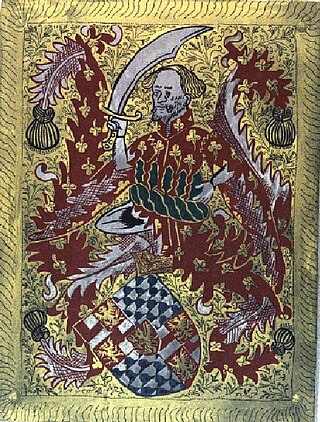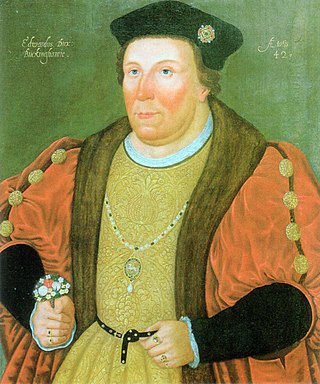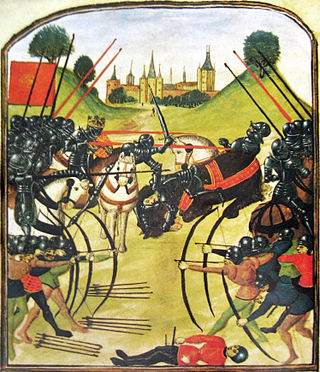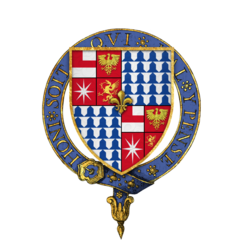
Henry VII, also known as Henry Tudor, was King of England and Lord of Ireland from his seizure of the crown on 22 August 1485 until his death in 1509. He was the first monarch of the House of Tudor.

The Battle of Stoke Field, which took place at East Stoke, Nottinghamshire, on 16 June 1487, may be considered the last battle of the Wars of the Roses, since it was the last major engagement between contenders for the throne whose claims derived from descent from the houses of Lancaster and York. The Battle of Bosworth Field, two years previously, had established Henry VII on the throne, ending the last period of Yorkist rule and initiating that of the Tudors. The Battle of Stoke Field was the decisive engagement in an attempt by leading Yorkists to unseat the King in favour of the pretender Lambert Simnel.
Lady Eleanor Talbot, also known by her married name Eleanor Butler, was an English noblewoman. She was a daughter of John Talbot, 1st Earl of Shrewsbury. After the death of Edward IV of England in 1483 it was claimed by Robert Stillington, Bishop of Bath and Wells, that she was legally married precontract to Edward, which invalidated the king's later marriage to Elizabeth Woodville. The evidence was examined and the Bishop was questioned by the Three Estates, who determined that Bishop Stillington's claim was valid. The finding rendered Edward IV's second secret marriage to Elizabeth Woodville bigamous, thereby making all seven children illegitimate, including Edward's sons, the so-called Princes in the Tower. As the oldest male blood relative of Edward IV, his brother Richard, Duke of Gloucester, was elected by the Three Estates to the throne as Richard III. Edward's sons remained in the royal apartments in the Tower and subsequently disappeared. Various explanations for their appearance have been put forward.

Jasper Tudor, Duke of Bedford was the uncle of King Henry VII of England and a leading architect of his nephew's successful accession to the throne in 1485. He was a member of the Tudor family of Penmynydd.

John Beaufort, 1st Duke of Somerset, 3rd Earl of Somerset, KG was an English nobleman and military commander during the Hundred Years' War. He was the maternal grandfather of Henry VII.

Richard Woodville, 1st Earl Rivers, also Wydeville, was the father of Elizabeth Woodville and father-in-law of Edward IV.

Anthony Woodville, 2nd Earl Rivers, was an English nobleman, courtier, bibliophile and writer. He was the brother of Queen Elizabeth Woodville who married King Edward IV. He was one of the leading members of the Woodville family, which came to prominence during the reign of King Edward IV. After Edward's death, he was arrested and then executed by the Duke of Gloucester as part of a power struggle between Richard and the Woodvilles. His English translation of The Dictes and Sayings of the Philosophers is one of the first books printed in England.

Edward Stafford, 3rd Duke of Buckingham was an English nobleman. He was the son of Henry Stafford, 2nd Duke of Buckingham, and Katherine Woodville, and nephew of Elizabeth Woodville and King Edward IV. Thus, Edward Stafford was a first cousin once removed of King Henry VIII. He frequently attended the courts of Henry VII and Henry VIII. He was convicted of treason and executed on 17 May 1521.

Carisbrooke Castle is a historic motte-and-bailey castle located in the village of Carisbrooke, Isle of Wight, England. Charles I was imprisoned at the castle in the months prior to his trial.

Francis II was Duke of Brittany from 1458 to his death. He was the grandson of John IV, Duke of Brittany. A recurring theme in Francis' life would be his quest to maintain the quasi-independence of Brittany from France. As such, his reign was characterized by conflicts with King Louis XI of France and with his daughter, Anne of France, who served as regent during the minority of her brother, King Charles VIII. The armed and unarmed conflicts from 1465 to 1477 and 1484–1488 have been called the "War of the Public Weal" and the Mad War, respectively.

The now-extinct title of Earl of Richmond was created many times in the Peerage of England. The earldom of Richmond was initially held by various Breton nobles; sometimes the holder was the Breton duke himself, including one member of the cadet branch of the French Capetian dynasty. The historical ties between the Duchy of Brittany and this English earldom were maintained ceremonially by the Breton dukes even after England ceased to recognize the Breton dukes as earls of England and those dukes rendered homage to the King of France, rather than the English crown. It was then held either by members of the English royal families of Plantagenet and Tudor, or English nobles closely associated with the English crown. It was eventually merged into the English crown during the reign of Henry VII of England and has been recreated as a Dukedom.
The Lord of the Isle of Wight was a feudal title, at times hereditary and at others by royal appointment in the Kingdom of England, before the development of an extensive peerage system.

The Battle of Saint-Aubin-du-Cormier took place on 28 July 1488, between the forces of King Charles VIII of France, and those of Francis II, Duke of Brittany, and his allies. The defeat of the latter signalled the end to the "guerre folle", a feudal conflict in which French aristocrats revolted against royal power during the regency of Anne de Beaujeu. It also effectively precipitated the end of the independence of Brittany from France.
Events from the 1460s in England.
Events from the 1480s in England. This decade marks the beginning of the Tudor period.

Thomas Grey, 2nd Marquess of Dorset was an English peer, courtier, soldier and landowner of the House of Grey.

Pierre Landais was a Breton politician who became the principal adviser and chief minister to Francis II, Duke of Brittany. Francis left Landais in control of the affairs of the duchy, producing resentment among local barons, who finally secured the overthrow of Landais' régime. The rise and fall of Landais undermined Francis' position and prepared the way for the annexation of Brittany by France.

The Wars of the Roses, known at the time and in following centuries as the Civil Wars, were a series of civil wars fought over control of the English throne from 1455 to 1487. The wars were fought between supporters of the House of Lancaster and House of York, two rival cadet branches of the royal House of Plantagenet. The conflict resulted in the end of Lancaster's male line in 1471, leaving the Tudor family to inherit their claim to the throne through the female line. Conflict was largely brought to an end upon the union of the two houses through marriage, creating the Tudor dynasty that would subsequently rule England.
Buckingham's rebellion was a failed but significant uprising, or collection of uprisings, of October 1483 in England and parts of Wales against Richard III of England.

John Fitzalan of Arundel was an English nobleman. He was called John Arundel.


















